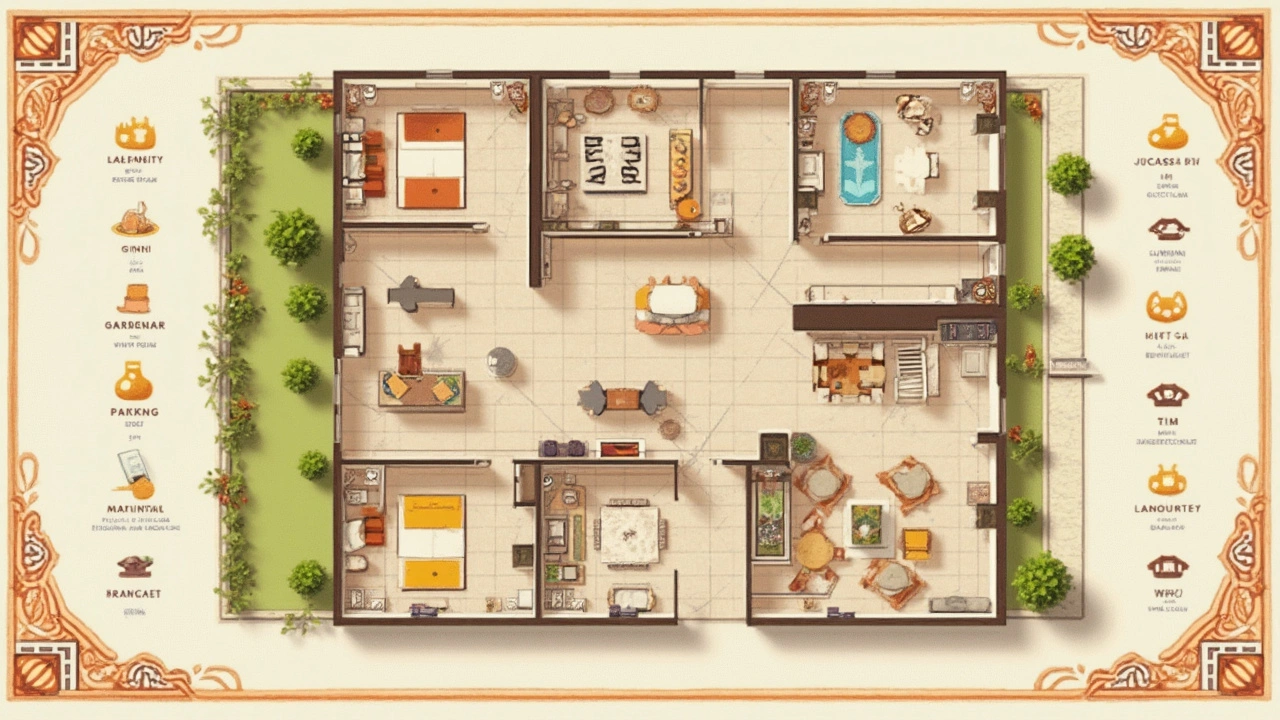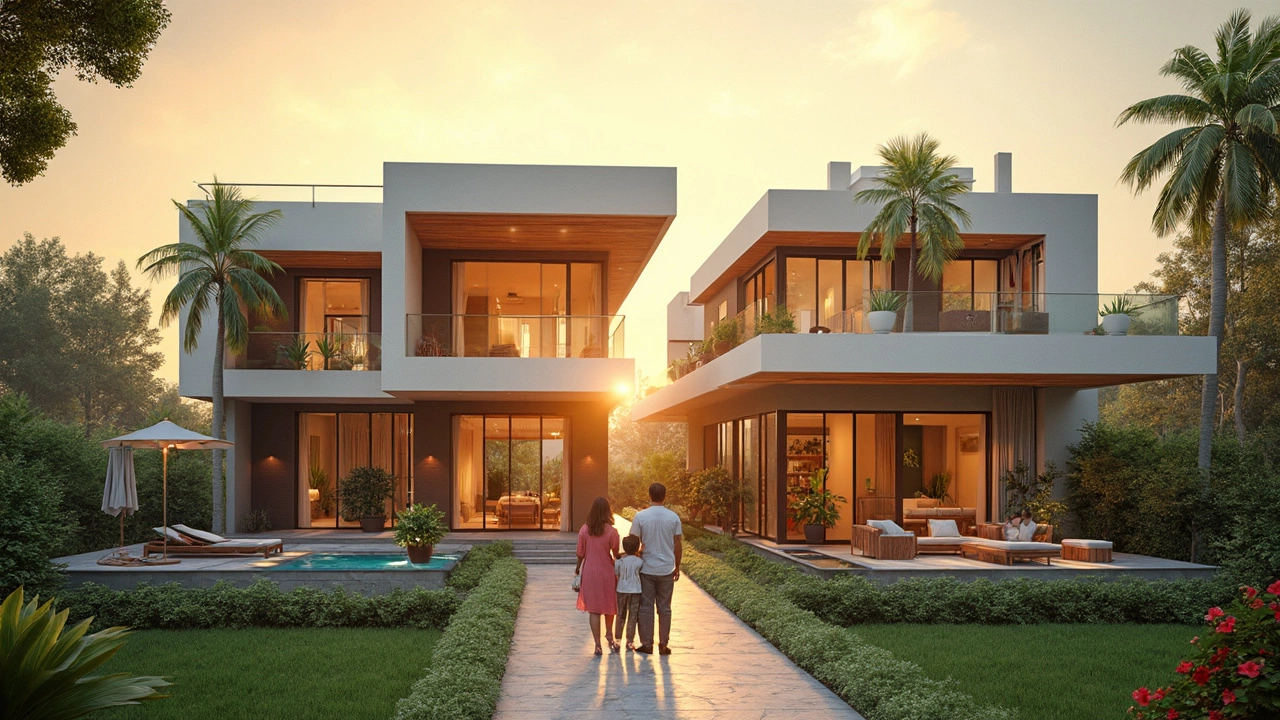Ever scrolled through villa listings and thought, “Wait, how big is a villa house supposed to be anyway?” The answer isn’t as clear as you think. Forget TV mansions—'villa' can mean anything from a roomy townhouse to an epic estate, depending on where you are and the real estate hype in play.
In most places, the word 'villa' brings to mind a house that feels bigger than your average family home, often with a chunk of land to stretch out on. But that doesn't mean every villa is massive. If you’re looking to buy, just know the square footage can jump all over the map. You might see a so-called villa at 1,600 square feet—and others tipping past 6,000.
To make things weirder, some realtors call any nice detached home a 'villa' just to grab attention. So size alone doesn't always tell the full story. If you want the space for a big family or wish to host epic get-togethers, it's smart to get clear numbers and not just rely on the name.
- What Defines a Villa's Size?
- Average Villa Dimensions: Real Numbers
- How Location and Lifestyle Change Everything
- Tips for Picking the Right Size Villa
What Defines a Villa's Size?
So, what actually decides if a house counts as a villa, and how big it needs to be to earn the label? Let’s break it down and trash the confusion. The whole 'villa' thing isn’t about some magic number, but there are a few real world factors that come up again and again.
First up, square footage. This is the actual inside living space. Villas almost always have more than your average suburban house, but there’s no global standard. In the U.S., something called a villa might be a single-story home with 2,000 square feet, but in Spain or Italy, you might see old villas running from 3,000 to over 8,000 square feet.
| Region | Common Size Range (sq ft) |
|---|---|
| United States | 2,000 – 4,000 |
| Spain | 3,000 – 6,500 |
| Italy | 2,500 – 8,000+ |
| Dubai | 3,500 – 10,000 |
Next, the land. Villas don’t just stand for bigger homes, but also usually come with private yards or gardens. For families, that’s huge—backyard barbecues, a small pool, space for kids, you name it. That extra land is one thing that separates a true villa from just a fancy house in the city.
Last, you’ve got the amenities. Things like private entrances, garages, maybe a guest house, and more bathrooms than bedrooms—these matter too. More perks usually mean more space. If a listing calls itself a villa but is squeezed onto a postage stamp lot without any privacy, question it.
- Villa house size isn’t all about the floorplan; outdoor space and special features matter too.
- Look for extras like pools, multiple patios, and dedicated guest wings if you want a real villa experience.
- Check local real estate listings to see what’s “normal” for villas in the area you’re considering.
Pro tip: Don’t just take the realtor’s word for it—always double check the square footage, the actual lot size, and see a floorplan if you can. What’s called a villa on the brochure could just be a slightly bigger house with a fancy name.
Average Villa Dimensions: Real Numbers
If you’re scrolling through villas for sale, knowing the typical size will help you filter out the listings that won’t even come close to your needs. So how big is a villa house, really? Here’s what the numbers say.
Across the world, a standard villa usually means more space than a regular single-family home. In the U.S., most villas range from 2,000 to 4,500 square feet, but some shoot up to 7,000 if you’re looking at luxury neighborhoods. In Europe, especially in places like Spain or Italy, a villa might start at 1,800 square feet and stretch up to 5,000. Villas in Dubai are in another league, with 3,000 square feet sometimes seen as "entry level." In Australia, villas are generally smaller, often hovering around 1,600 to 2,400 square feet because of land costs in urban areas.
Here’s a quick breakdown for easy comparison:
| Region | Typical Villa Size (sq ft) |
|---|---|
| USA | 2,000 – 4,500 |
| Spain / Italy | 1,800 – 5,000 |
| Dubai | 3,000 – 7,000+ |
| Australia | 1,600 – 2,400 |
When you break it down further, the layout is just as important as the total size. Most villas have:
- 3 to 6 bedrooms
- Spacious kitchens and dining areas
- Multiple bathrooms (at least two, usually three or more)
- Open living spaces
- Private outdoor areas or gardens
- Garages, often for two or more cars
The villa house size you choose should reflect how you actually live. If you’re not filling up five bedrooms or don’t host big family meals, maybe a smaller villa might fit better. On the flip side, if you want space for a home gym, playroom, and an office, the bigger homes make sense.
Don’t just stop at numbers on a listing. Always check floor plans and ask for square footage that includes balconies, garages, or outdoor living—sometimes sellers play loose with what they count.

How Location and Lifestyle Change Everything
You can’t really talk about villa house size without talking about where it sits on the map. Stuff costs more—and space shrinks—when you’re close to the action. For example, a so-called villa in a city like Dubai or Singapore might be about 2,000 square feet, maybe 3,000 if you push it. Head out to the countryside in Spain or Greece, and suddenly villas balloon up to 5,000 square feet—sometimes way more—with huge gardens and even space for a pool or two.
It’s not just the country versus city thing, either. Beachfront villas tend to pack in more perks (think direct beach access or an extra guest suite), but you’ll notice the square footage doesn’t always stack up against the price. You’re paying for that view and location, not just the concrete and lawn.
Lifestyle plays a massive role too. Some folks want big open rooms and private wings for guests or home offices. Others just want easy maintenance and a lock-and-leave setup for weekends and holidays. Villas aimed at families often have more bedrooms and play areas, while those meant for couples or retirees might double down on entertaining spaces instead.
Here’s a peek at typical villa house sizes in different spots:
| Location | Average Size (sq ft) |
|---|---|
| Downtown Dubai | 2,100 |
| Singapore Suburbs | 2,600 |
| Spanish Coast | 4,000-6,000 |
| US Suburbs (Florida) | 3,500 |
If you’re actively searching for a villa house size that fits your needs, get clear on what matters more: sprawling space or prime location? Crunch those priorities before you get swept up by glossy listing photos.
Tips for Picking the Right Size Villa
Not all villas fit everyone the same way. Before you fall for the photos, stop and ask: how much space do you really need, and what will you actually use? Bigger isn’t always better—it just means more to clean, heat, cool, and pay for. In the villa market this year, plenty of families are sizing down instead of up because less wasted square footage means lower bills. Data from the 2024 Global Villa Survey showed that buyers who picked homes with 25% less ‘dead space’ reported fewer regrets than those who went big for bragging rights.
Here are some no-nonsense tips to help you pick the right fit:
- Think about your family’s habits. If everyone spreads out for privacy, extra bedrooms or a home office make sense. But if you’re always together in the kitchen or living room, a huge unused dining room is just dead space.
- Consider what kind of guests you host. Regular sleepovers or boisterous holiday parties? A guest suite or bigger common areas might pay off. Otherwise, you could be paying to heat empty rooms.
- Don’t ignore outdoor space. A typical villa gives you a chunk of yard or terrace. Ask yourself if you’ll actually garden or throw backyard barbecues, or if that land will just eat into your budget.
- Look at your day-to-day lifestyle. Families with kids and pets usually want secure, open areas. Remote workers value a quiet study or office. Know your deal-breakers before touring that dreamy listing.
| Villa Size (sq ft) | Fits Best For | Notes |
|---|---|---|
| 1,600 - 2,500 | Couples, small families | Low upkeep, ideal for first-time buyers |
| 2,500 - 4,000 | Average families, occasional guests | Room to grow, often with small yard |
| 4,000 + | Big families, those who entertain often | Higher energy and cleaning costs |
To put it simply: don’t just chase square footage for the sake of a bigger number. Villa house size should match your day-to-day life, not just your Instagram dreams. Like my kid Fern always says when picking a pizza, "You want enough, but not so much you’re stuck with cold leftovers." So true—even if she’s talking about cheese and not real estate.
"Most regret in home-buying comes from ignoring your real lifestyle needs for extra space you rarely use." — Sarah Mitchell, Senior Analyst at Realty Insights Europe

